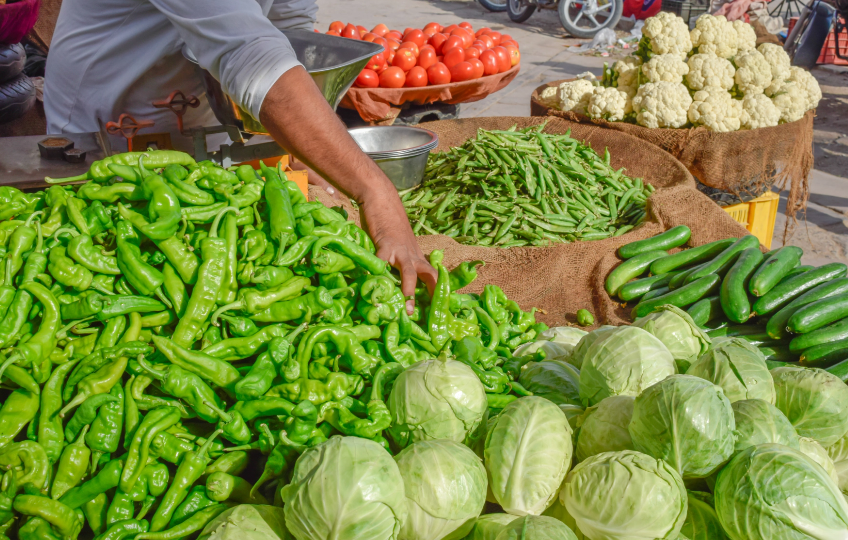A Glimpse into the Life of an Invisible Workforce – Street Vendors of India
“Every day, I stitch clothes for babies, and my husband ventures out to sell them in the Gautam Nagar market area in Delhi. We spend Rs. 50 or 100 every day to secure a decent vending spot,” says Parveen, who does home-based work in Delhi.
India’s bustling streets are a witness to the entrepreneurial spirit thriving in the country, with new small and micro enterprises cropping up every day. From people selling books at traffic signals to the bustling weekly markets and shawl sellers coming to our doorstep, at the heart of all this activity are the unsung heroes—the street vendors. Street vendors constitute nearly 2% of India’s urban population, and although often overlooked, they play a crucial role in shaping the urban landscape. To help the street vendors bounce back post-pandemic, the government, through PM SVanidhi, has helped the community gain access to financial assistance, digital literacy, and social security. However, the unorganised nature of the system and irregularities in defining who street vendors are make this a multi-layered problem. This often results in their wellbeing, including their physical, mental, emotional, and financial health, being overlooked. We must delve deeper into the world of people like Parveen, exploring their challenges, triumphs, and the cues they provide for the socio-economic fabric of the nation, to gauge the need for prioritising street vendor wellbeing.
According to the National Hawkers Federation, there are about 4 crore street vendors in urban India, who form a significant part of India’s informal economy, contributing immensely to employment and local commerce. With an average daily turnover of INR 1,100 per day per vendor, the total turnover of 1 crore street vendors in India will be as much as INR 1,100 crore per day, which is a huge contribution to the GDP.
Perils of the informal workforce
There is no better time than the festive season to recognise the significance of street vendors in helping us acquire everything from decor to delicacies. After the multiple lockdowns post-pandemic, it has taken 3 years to bounce back, with the economy and enterprises still recuperating. The worst hit by the lockdowns, changing protocols, and fluctuating markets were the people at the bottom of the informal economy—the street vendors. With no social security, no business, and no certainty over when the markets will open, the group fell into the most vulnerable population.
A research study focusing on the effects of the pandemic on female street vendors in Delhi revealed that 54% of these women have resorted to taking loans to support themselves during the lockdown, and 37.1% of the survey participants are currently facing challenges in repaying these loans. The informal nature of work also subjects the street vendors to another pertinent problem—that of space.
The Street Vendor Act 2014 has undoubtedly marked a significant step forward in recognising the necessity of local governance to ensure the rights of street vendors. However, the implementation of this system continues to present various challenges.
For example, findings from a survey of over 50 retailers in 15 locations across India show that the people who lost their jobs in cities and could not return to their villages switched to vending fresh produce and groceries. Thus, migration of street vendors or switching professions due to calamities like the pandemic and hence their registration or identification is an issue.
For example, in Delhi, out of roughly 300,000 street vendors, only about 131,00 have some form of occupational identification. In every city, there is always a constant tussle between the authorities and the vendors over space. The lack of trust between these two groups and the repetition of anti-encroachment activities for the civic authorities results in loss of business and harassment for the street vendors without any solution in most cases.
Street vendors like Parveen’s husband, Mirza, who find it difficult to find a vending spot end up vending in zones with no shade, beside swarms, or simply on the streets bearing the heat, rain, dust, or pollution. We see national and international deliberation on climate change currently, but climate change is something that directly affects street vendors. The heat waves and floods are causing significant displacements, less business, and in extreme cases, even deaths.
Approximately a third of the street vendor population comprises women, and despite this, streets are generally perceived as unsafe workspaces for them. In addition to facing issues such as sexual and verbal harassment from fellow vendors and customers, women encounter additional obstacles in securing prime vending locations due to physical limitations that prevent them from operating carts.
Resilience Amidst Adversity
Despite the many challenges, street vendors have displayed remarkable resilience. While the pandemic has been a significant setback, to boost street vendors, the government initiated the PM Svanidhi scheme, aimed at enhancing the financial inclusion of this community. This scheme provides a loan of INR 10,000/- to start or revive microenterprises. Civil Society Organisations have also helped in the thorough implementation of this scheme. Despite discrepancies in identification, registrations, etc. of the street vendors, there sure has been an increase in the awareness and launch of different initiatives like digitalisation.
The biggest feat post-pandemic has been the integration of technology into their everyday business. Street vendors have also evolved with time and have made technology a part of their everyday lives, like UPI payments, integration with food delivery platforms, etc. Government-led campaigns like ‘Main Bhi Digital’ and support from organisations and enterprises have created a lot of awareness among the community and enabled access to technology. Efforts like these have also opened doors for them to imbibe and practice innovative strategies, such as leveraging social media for marketing and adapting to changing consumer preferences.
Apart from Digital Literacy and Inclusion, another pathway to reducing the vulnerability of the community could be awareness, the right information, and assistance for increasing the uptake of Social Protection schemes. The biggest respite for Parveen and her husband in times of extreme crisis was getting registered for various government schemes. “I learned about Sukanya Samriddhi Yojana and got our account opened at the Post Office. We are saving INR 2500 every month for a bright future for our daughter. We also got registered for Ayushmaan Bharat and are not so scared of medical expenses now,” according to Parveen.
Issues and conflicts that street vendors face due to the sharing of urban spaces remain unresolved in numerous cities around India. However, there have been cases such as that of Bhubaneshwar in Odisha, which exemplifies an overregulated informal economy. It has established aesthetically pleasing fixed kiosks in legally sanctioned vending zones. This has only been possible through the political will and strong leadership shown by vending committees, social dialogue, and partnerships among all the stakeholders, including public, private, street vendor rights-based federations, and civil society.
Efforts are being actively directed towards realising the wellbeing of street vendors, as evidenced by initiatives such as PMSVANidhi, which has already benefited 7.45 lakh beneficiaries. However, there remains a substantial distance to traverse in this endeavour.
The invaluable contribution of street vendors to India’s socio-economic landscape is undeniable and calls for a collective effort from the government, civil society, and the private sector to create an environment where street vendors can thrive and contribute meaningfully to the nation’s progress.
Excerpts of Parveen Story have been taken from a blog published by Upfront:
1. https://upfront-latest-v4.vercel.app/blogs/parveens-journey-of-hope-empowering-the-street-vendors
2. https://ccs.in/rights-restrictions-and-rule-law-covid-19-and-women-street-vendors
3. https://www.researchgate.net/publication/359618673_URBAN_STREET_VENDORS_IN_INDIA
4. https://www.niti.gov.in/sites/default/files/2023-06/Best-Practices.pdf
5. https://www.wiego.org/sites/default/files/publications/files/Kumar_WIEGO_PB7.pdf


